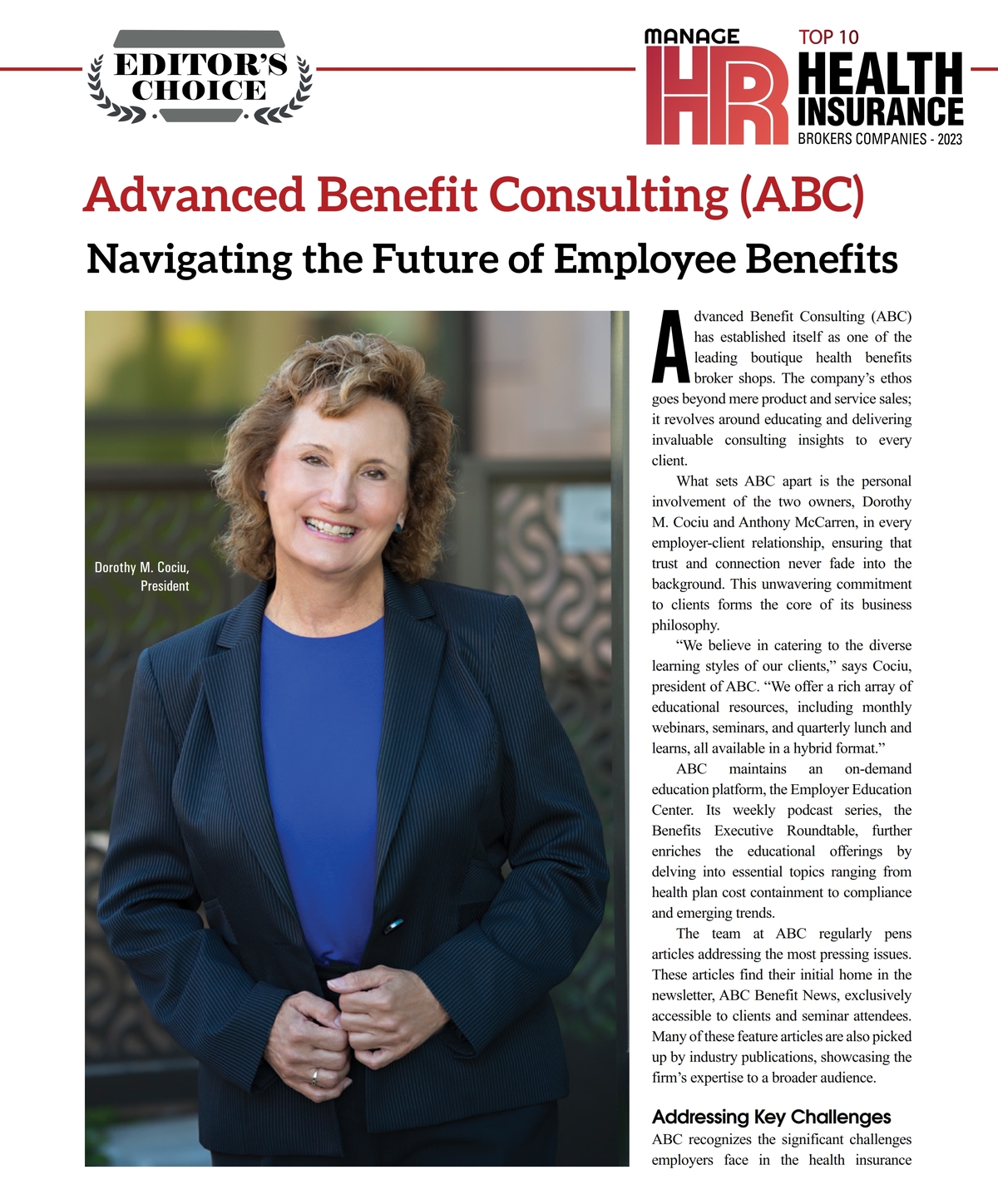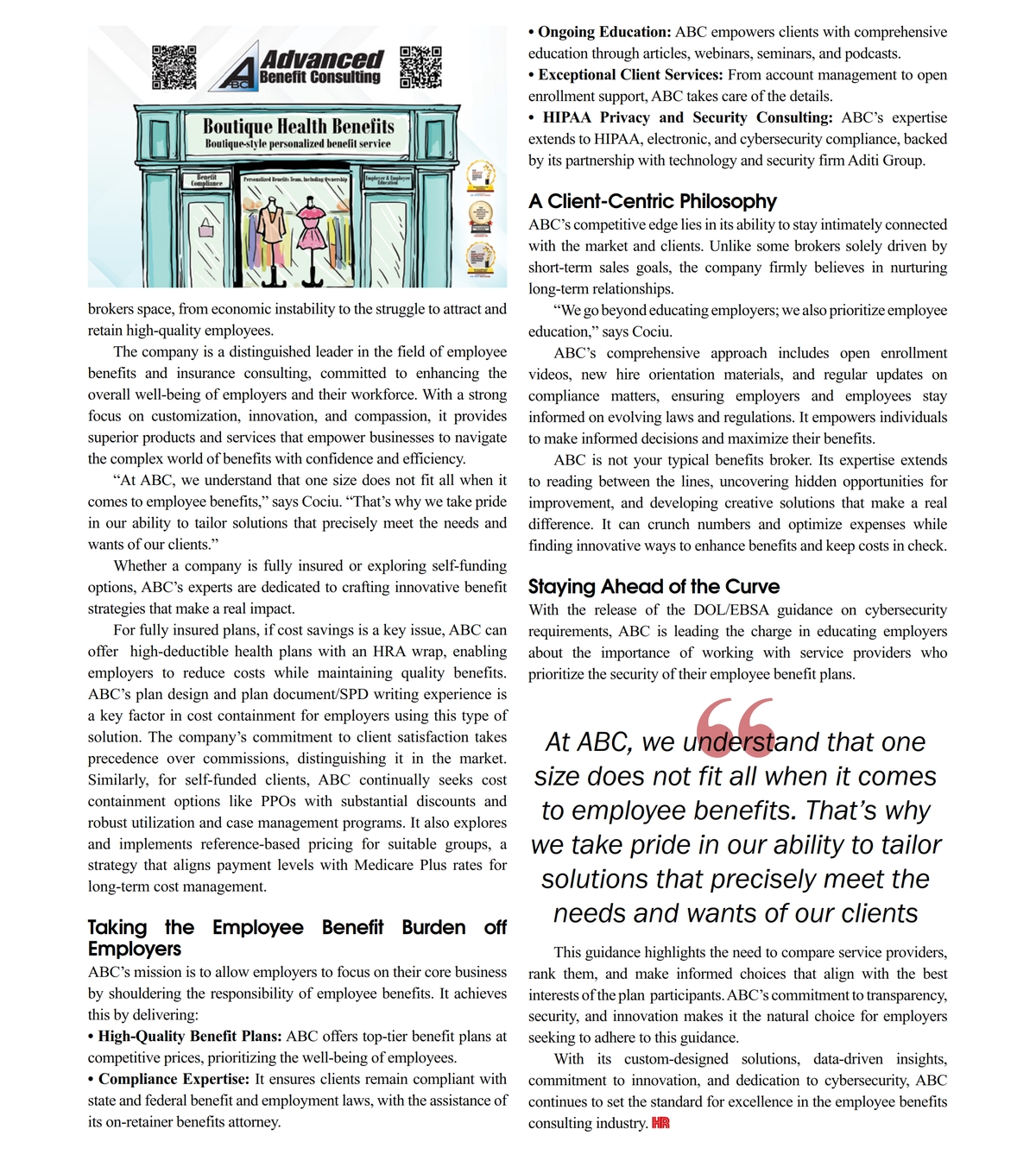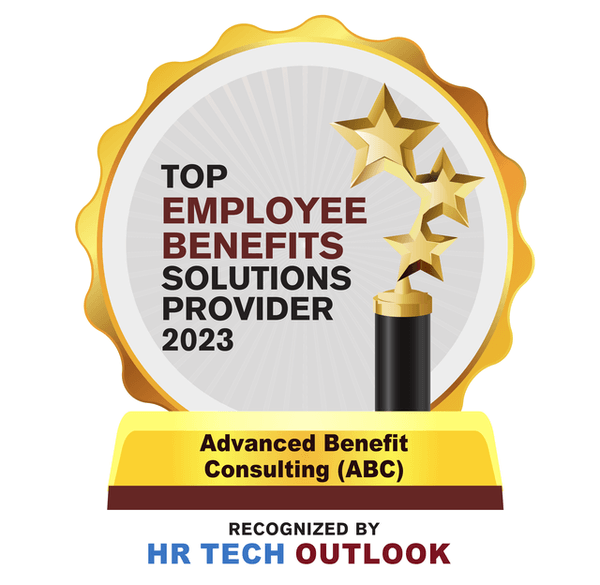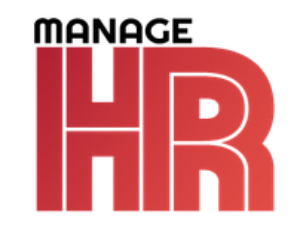Manage HR 2023 Award


HR Tech Outlook Award 2023
Workplace Violence… Is It Becoming The Norm, Or Can It Be Prevented?
States Begin to Enact Workplace Violence Prevention Laws July 1, 2024
By: Dorothy Cociu, RHU, REBC, GBA, RPA, LPRT
President, Advanced Benefit Consulting & Insurance Services, Inc.
It’s the middle of the afternoon and you’re having a really good day at work. You turned in your report that resulted in high praise earlier, you closed a huge sale and you and your team just received a very loud, standing ovation at your staff meeting. Everyone seems happy. There are smiles all around; the atmosphere is positive and invigorating, and you’ve never been so happy in the workplace. What more could you ask for? Perhaps the answer to that question could be simply to feel safe.
Your company has grown significantly, and you can no longer have staff meetings in a training or conference room. You are in the open in the warehouse, which is the only place large enough to gather the entire warehouse day shift, office/administration staff, sales and all other personnel. As the applause begins to dissipate, there is a loud series of pop-pop-pop sounds followed by screams of terror, and everyone begins running, but no one knows where to run to. Eyes are filled with horror and tears, and people are literally shoving and pushing others to get to an exit. There are people lying on the floor being trampled, and there are large warehouse shelving units and cabinets that are toppled over and inventory is crashing onto people before hitting the floor.
Everyone appears to be in shock, and no one knows what to do. After a few seconds it begins to register that something really bad is happening. Then you hear people screaming “Shooter” and then more shots are heard, closer this time. You see people with splatters of something red on their clothing as they run by, and you realize that it must be blood. You instinctively turn toward the direction they are running from and you see something that should only be seen in a movie, but instead, it’s right in front of you. Four people are lying on the floor, injured or possibly worse. Then you see the barrel of a very large gun coming from around the corner and out into the open toward you. You watch in what appears to be slow motion and you see the gun being fired, and it’s aiming in your direction. At that point, it all becomes a blur, as you feel something hit your leg and your body begins to shake as the pain surges through you. Before you black out, you see images of your family flash before your eyes….
Most of us think of our top two priorities in life as our family and our jobs. Both should be safe and secure, and both should be filled with a healthy combination of joy, frustration and stress. We all hope that the joy far outweighs the frustration and stress. But what happens when somewhere we are all supposed to feel safe turns into a place of chaos and trauma, violence and disaster?
Workplace Violence & Workplace Violence Plans
What is Workplace Violence? As taken from California’s Cal-OSHA website, Per Labor Code section 6401.9, “workplace violence” is defined as any act of violence or threat of violence that occurs in a place of employment. This includes, but is not limited to, the following:
- The threat or use of physical force against an employee that results in, or has a high likelihood of resulting in, injury, psychological trauma, or stress, regardless of whether the employee sustains an injury.
- An incident involving a threat or use of a firearm or other dangerous weapon, including the use of common objects as weapons, regardless of whether the employee sustains an injury.
- The four types of workplace violence defined in Labor Code section 6401.9.
Why is all of this so important now? As stated on the Cal-OSHA website, On September 30, 2023, California Senate Bill 553 (Cortese) was signed into law and California Labor Code section 6401.9 will be in effect and enforceable on July 1, 2024. Employers that fall within the scope of this law must establish, implement, and maintain an effective written Workplace Violence Prevention Plan that includes but is not limited to the following:
- Identifying who is responsible for implementing the plan
- Involving employees and their representatives
- Accepting and responding to reports of workplace violence and prohibit employee retaliation
- Communicating with employees regarding workplace violence matters
- Responding to actual and potential emergencies
- Developing and providing effective training
- Identifying, evaluating, and correcting workplace violence hazards
- Performing post incident response and investigations
Categories of Workplace Violence
Unfortunately, these scenarios, as well as overall violence in the workplace, have become far too common. There are four categories of workplace violence, according to the National Institute for Occupational Safety and Health: 1) Criminal Intent; 2) Customer/Client; 3) Worker-on-Worker, and 4) Personal Relationship, which overwhelmingly targets women.
I was shocked when I read some of the statistics on workplace violence while researching for this article. Assaults resulted in 57,610 injuries in the workplace in 2021-2022, according to the National Safety Council (NSC). In 2022, 525 fatalities due to assault were reported, according to Injury Facts. Every year, according to NSC, thousands of American workers report having been victims of workplace violence. Certain industries, including health, service providers and education, are more prone to violence than others. OSHA reports that taxi drivers, for example, are more than 20 times more likely to be murdered on the job than other workers. The Centers for Disease Control and Prevention (CDC)’s National Institute for Occupational Safety and Health (NIOSH) reports that in 2020, health care and social assistance workers had an incidence rate of 10.3 out of 10,000 full-time workers) for injuries resulting from assaults and violent acts by others. The rate for nursing and personal care facility workers was 21.8. According to the NSC, assault is the fifth leading cause of workplace deaths.
Active Shooter v Other Workplace Violence
The deadliest situations of course involve an active shorter. The US Department of Homeland Security defines an active shooter as someone “actively engaged in killing or attempting to kill people in a confined and populated area.”
The US Bureau of Labor Statistics states that 20,050 workers in the private industry experienced trauma from nonfatal workplace violence in 2020, which required days away from work. Of these victims who experienced trauma from workplace violence, 73% were female, 62% were aged 25 to 54, 76% worked in the healthcare and social assistance industry, and 22% required 31 or more days away from work to recover, and 22% involved 3 to 5 days away from work. That same Bureau reports that 392 US workers were workplace homicide victims in 2020 that died from homicide. Of those, 81% were men, 44% were aged 25 to 44, 28% were Black and 18% Hispanic.
According to The Economics Daily (TED) of the Bureau of Labor Statistics, the five occupational groups with the most workplace homicides in 2020 were sales and related (92), transportation and material moving (51), management (29), construction and extraction (20), and production (18). Non-fatal workplace intentional injuries by another person that required at least one day away from work in 2020, included 18,690 in Service, 8,590 in Healthcare Practitioners and Technical, 5,470 in Education instruction and libraries, 1,560 in transportation and material moving, and 1,360 in management, business or financial areas.
The statistics are overwhelming, but we care mostly about how it affects us, our workplace and our lives.
Cal-OSHA has posted this on their website: “According to the latest data, in 2021, 57 working people died from acts of workplace violence in California. In the United States, an average of 1.3 million nonfatal violent crimes in the workplace occurred annually from 2015 to 2019. For further details see Indicators of Workplace Violence, 2019 (published 2022).”
I recently spoke with Michael Julian, CEO from ALIVE Active Shooter Survival Training Program, MPS Security and Protection and National Business Investigations, Inc. and Tony Clubb, Active Shooter Master Trainer from ALIVE Active Shooter Survival Training Program about workplace violence and active shooter situations. Michael was a guest on my Benefits Executive Roundtable podcast this past season (S5 E16) and was very passionate about protecting workers from active shooter situations, and how common they have become, particularly when comparing to a decade ago, which mirror some of the statistics stated above.
“There are roughly 2 million victims of workplace violence annually in the United States Each year,” stated Michael. “According to Safety and Health Magazine ‘over the last six years of the study period, workplace violence-related deaths rose 11%, from 409 in 2014.’ In addition, we have seen a steady rise in the number of active shooter incidents over the last 20+ years. From 2000 through 2019, there were 333 active shooter incidents in the US. From 2020 through 2022, there have been 151.’”
Workplace violence can happen in any city, any state, any type of workplace. All you need is a disgruntled current or former employee or a family member of such, and extenuating circumstances which cause that person to take drastic measures.
California’s SB 553- Workplace Violence Prevention
California is leading the nation (no surprise there) with legislation (SB 553) set to go into effect on July 1, 2024, which includes massive requirements for workplace violence training, logging and other tedious requirements. Although I’ll be discussing the upcoming California state legislation, the same circumstances may happen in whatever state you are in, regardless of whether or not you have state laws to help educate or prevent certain activities.
Workplace Violence Plans and California’s SB 553
I asked Michael Julian how other states are responding to workplace violence in general and if they have or expect to have similar laws to CA’s SB 553 in the near future.
“There are currently no other states mandating such stringent workplace violence prevention laws as SB 553,” Michael replied, “but California is somewhat of a trend-setter in areas like this, so most states will begin to follow suit by implementing similar laws.”
So how comprehensive is SB 553? I asked Michael about this and some of the requirements he felt employers aren’t and won’t be ready for by the July 1, 2024 deadline. “SB 553 requires organizations to develop a Workplace Violence Prevention Plan, establish effective training, maintain a Violent Incident Log, investigate incidents, and retain records for specific lengths of time. I think the infrastructure the organization has in place will determine which component will cause an organization the most trouble. For example, a larger organization with HR resources in place may have the most trouble getting their staff the required training annually. The training must be interactive, and the employees need to be able to ask questions. On the other hand, a smaller organization may find it easier to give the training to their staff but may struggle with the more technical parts such as developing the WVPP with input from employees/bargaining units, completing the physical security audit and providing the active shooter training.”
Are most California employers ready to implement SB 553? “I think organizations that have a fully staffed HR department or have an HR firm providing consultation, are probably moving in the right direction. However, it appears that many businesses that do not have these resources currently in place are unaware of the requirements this legislation mandates,” stated Michael.
I also asked our Benefits Attorney, Marilyn Monahan, the same. “I suspect many employers are not prepared. Cal-OSHA is working to get the word out, and so are many law firms, HR consultants, and other service providers. And we do know that many employers have gotten the message and are starting to work on implementation. However, the law is sweeping in its application, and I would not be surprised if many employers—especially those who do not have a lot of resources available to them—are unaware or unprepared for implementation.”
Implementation is always the key to law enactment and enforcement. This law is wide-reaching and will require a tremendous amount of management and Human Resources labor hours to understand and implement.
“This new law will add a massive amount of new work to many HR departments that are already overtaxed, especially if they try to create and implement what is necessary to fulfill these new requirements themselves,” stated Tony Clubb. “They will have three choices; completely create everything from scratch themselves, obtain a package of templated documents and the training presentation to complete and deliver themselves, or hire an outside consultant to do all the work for them, which could be quite expensive.”
Marilyn Monahan was concerned about the complexities of the law and made these comments: “Employers need a written workplace policy, and there are numerous steps involved in putting the policy together. For example, they have to develop procedures to obtain the active involvement of employees and authorized employee representatives in developing and implementing the policy. Once the policy is written, they have to implement it. An important part of implementation is mandatory training. To start the process, Cal-OSHA has issued a model policy. While the model policy is a helpful starting point, it must be tailored to address the specific circumstances of the employer’s workplace—and for employers with multiple facilities, that means multiple policies or procedures. The law also includes detailed record-keeping requirements.”
The Cal-OSHA Model policy and related documents can be found at: https://www.dir.ca.gov/dosh/Workplace-Violence.html.
What Employers Must Know; Even Those Who Don’t Believe it Could Happen to Them
In my recent podcast interview with Michael Julian (Benefits Executive Roundtable, S5 E16) we talked in detail about workplace violence, active shooter situations and the reality of today’s world, as well as the inability or unwillingness of some employers to actually perceive that events like active shooters could happen in their workplace. I asked Michael in the podcast, and again recently for this article, if he thinks most employers are equipped to handle an active shooter situation.
“No,” said Michael, absolutely. “A small percentage of employers have implemented proper physical security apparatus to harden themselves as a target or provided adequate active shooter response/survival training. Per statistics published on Zippia.com, ‘Although 62% of companies view an active shooter as a top threat, as many as 79% of businesses report feeling unprepared for an active shooter, meanwhile, 61% of these companies do not run any proactive active shooter preparedness drills or training for their employees.’”
If the unthinkable happens, there are things an employer should know to do immediately after an Active Shooter is known to be on the premises. I asked Tony Clubb to walk us through those first critical steps.
“Previous to any type of catastrophic violent event, all employees should be trained on the appropriate way to respond to such an event,” stated Tony. “Employers and employees should follow these steps upon learning of the presence of an active shooter:
- ASSESS the situation to determine which of the following next steps are appropriate and call 911 immediately.
- If possible, LEAVE the danger zone as quickly and safely as possible, notifying others of the danger.
- If leaving is not possible, attempt to IMPEDE the killer’s ability to get to you by creating time and space.
- If no other option is available, commit to VIOLENCE against the killer to neutralize the threat.
- When you believe the threat is over, EXPOSE your position carefully. There may still be a threat, and law enforcement will not know who the threat is so they may treat you as one.”
Can the risk of an active shooter be minimized or prevented? Are there steps that can be taken to decrease your risk of an active shooter? I asked Michael what he thought the five best things an employer can do to minimize the risk of an active shooter, if that’s at all possible. Michael didn’t even hesitate or have to think about it when I asked. “An employer must…
- Provide effective training to staff on how to prepare for and respond to an incident.
- Ensure your site is hardened by making it difficult for someone to gain unauthorized access and setting up safe rooms where staff can shelter in place.
- Ensure resources are available for staff that are struggling, ensure they know how to utilize them, and ensure they know how to refer people to them.
- Establish an effective reporting system that allows staff to remain anonymous if they choose.
- Develop a timely process to investigate reports of workplace violence or concerns for workplace violence.”
None of that sounds easy and it all sounds very time-consuming and stressful for the employer; particularly their HR Department. Does SB 553 apply to all employers or are there employers who are exempt from the law? Marilyn Monahan advised “Exempt employers include: health care facilities that are in compliance with an existing mandate that they have a workplace violence policy in place; employees teleworking from a location of the employee’s choice, which is not under the control of the employer; and places of employment where there are less than 10 employees working at the place at any given time and that are not accessible to the public, if the places are in compliance with existing rules on Injury and Illness Prevention Programs.”
Michael Julian and Marilyn Monahan provided me with a list of the types of exempted employers for SB 553 requirements:
- Health care facilities, service categories, and operations covered by Section 3342 of Title 8 of the California Code of Regulations.
- Employers that comply with Section 3342 of Title 8 of the California Code of Regulations.
- Facilities operated by the Department of Corrections and Rehabilitation, if the facilities are in compliant with Section 3203 of Title 8 of the California Code of Regulations.
- Employers that are law enforcement agencies that are a “department or participating department,” as defined in Section 1001 of Title 11 of the California Code of Regulations and that have received confirmation of compliance with the Commission on Peace Officer Standards and Training (POST) Program from the POST Executive Director in accordance with Section 1010 of Title 11 of the California Code of Regulations. However, an employer shall be exempt pursuant to this subparagraph only if all facilities operated by the agency are in compliance with Section 3203 of Title 8 of the California Code of Regulations.
- Employees teleworking from a location of the employee’s choice, which is not under the control of the employer.
- Places of employment where there are less than 10 employees working at the place at any given time and that are not accessible to the public, if the places are in compliance with Section 3203 of Title 8 of the California Code of Regulations.
Workplace Violence Prevention Implementation, Training & Resources
Whether the employer is in California and must meet the SB 553 requirements or is located in another state, most of the things discussed in this article would be relevant (other than those specific requirements of SB 553) to any employer, anywhere. Whether you’re in California or not, but want to address the possibility of workplace violence and create a plan on what to do if the unthinkable happens, human resources departments, which are already spread too thin, probably aren’t going to be able to do this on their own. Nor would their executives want them to. These are complex issues and preparation is exhaustive. If you have to or want to implement a workplace violence prevention program, an easy place to start is at the Cal-OSHA website, where they have posted Fact Sheets and have created model prevention plan samples, depending on industry. You can find these at: https://www.dir.ca.gov/dosh/Workplace-Violence.html
However, it’s important to keep in mind, these are just models. I asked Marilyn if she had words of caution or advice for employers when using the government-provided models. “The guidance and the models are a good starting point, but more work will have to be done. Employers may need to work with outside counsel, an HR consultant, or a workplace safety consultant in order to put an effective and compliant policy in place.”
I also asked if Marilyn would have any recommendations for employers when determining whether to try to do the implementations themselves in-house or hire outside experts. Marilyn recommended: “As is the case with any service provider, compare experience, references, and cost to ensure the employer is retaining the services of a competent and effective partner in this process.”
I also asked Tony what they would recommend. “If an employer has adequate resources in-house, they should use them,” stated Tony. “If not, for something as serious as workplace violence prevention, we recommend using consultants with the appropriate expertise and experience to address this issue.”
The Aftermath
The actual event is only the beginning for some. Often it involves ongoing medical care and therapy, grief counseling, treatment/counseling for post traumatic stress or depression or survivor guilt syndrome, just to name a few.
… You open your eyes and realize everything is a bit blurry. You feel groggy and heavily medicated. Then you begin to realize that you’re in a hospital. Why am I here, you ask yourself? Then you begin to recall. Work, people running, scared, gun, pain and then… nothing. You passed out from the pain and blood loss from a gunshot wound to the leg. You look down and are relieved to see that your limbs seem to be in tact, but your leg is heavily wrapped with something and is elevated. You can’t quite process it yet.
The nurse, who had been doing work on a monitor by the cabinet a few feet from you, now turns to you and speaks. “You’re awake,” she states. “It’s ok. There was an incident, you were hurt, but you’re better now. You had surgery.” She goes on to explain that you were shot in the leg, and although you lost a lot of blood, they were able to surgically repair your leg, but you should be prepared for some long-term therapy and a somewhat long road to recovery.
“My family,” you reply in a soft and raspy voice you don’t recognize. “Are they ok? Do they know? Are they afraid? I have to talk to them!”
“It’s ok,” says the nurse calmingly. “They are here. That’s a big-hearted bunch out there. You’ve got family, friends and co-workers out there, all worried about you. I’ll go out and let them know you’re awake and talking, and soon I can let them in to see you, two at a time.”
“Wait,” you ask, “the others? Is everyone ok? I saw… I saw blood, and a gun, and a shooter… Did everyone make it? Is everyone ok? What happened?”
The nurse’s face suddenly looks sad. “You were one of the lucky ones. You were shot in the leg… Others weren’t so lucky. I’m afraid there were some casualties, and a lot more injuries. We’ll fill you in later, after you’ve been able to see some family. Sound good? I’ll be right back.”
As soon as the nurse leaves the room, it all begins to come back to you, and you start to feel overwhelmed, frightened, and very sad. But you’re full of questions and simply overwhelmed. Who died? Who is also injured? Who was the shooter, and why did he do this? Just as you start to cry, the smiling faces of your wife and your daughter run into the room to greet you. You fight back the tears, and open your arms for them…
Three months later, you still aren’t back to work, as the intense physical therapy for your leg injury continues. You tried working remotely from home, but you just can’t seem to concentrate. You have also been seeing a therapist about your post-traumatic stress disorder and your survivor’s guilt, which developed after you discovered nine people died that day, and three were your friends. 17 others were injured, and 11 still haven’t returned to work. Your company offered an employee assistance program and brought in special counselors, but it just hasn’t been the same. …
The violent event may be over, but the recovery will take much more than surgery to heal. The emotional part of workplace violence will be with you for the rest of your life, and it’s after the event, that’s where the real work begins.
Employers may want to consider, both inside California where required and out, if they’ve done enough to prevent this type of thing from happening, and how they should prepare and train their employees. Maybe some prevention steps could decrease the likelihood, and if it does happen, decrease the number of casualties and injuries. We all want to feel safe at our jobs.
##
Author’s Note: I’d like to thank Marilyn Monahan, Monahan Law Office, Michael Julian and Tony Clubb from ALIVE Active Shooter Survival Training Program, MPS Security and Protection and National Business Investigations, Inc. for their assistance with this article. Marilyn can be reached at: marilyn@monahanlawoffice.com. Michael can be reached at: mjulian@investigations-nbi.com, or Michael Julian, CPI PPS CSP, CEO, at 866-624-8050 x26, and Tony Clubb can be reached at: tclubb@aliveactiveshooter.com. Michael and Tony offer A.L.I.V.E. Active Shooter Survival Training Program at: www.ActiveShooterSurvivalTraining.com
Reference Sources:
Cal OSHA website and California Department of Industrial Relations Division of Occupational Safety & Health, Fact Sheet, Workplace Violence Prevention in General Industry (Non-Health Care Settings)- Information for Employees; California Department of Industrial Relations Division of Occupational Safety & Health, Fact Sheet, Workplace Violence Prevention in General Industry (Non-Health Care Settings)- Information for Employers; Cal-OSHA’s Workplace Prevention Model Plan, available at: https://www.dir.ca.gov/dosh/Workplace-Violence/General-Industry.html. Other reference Sources Mentioned in this Article: https://www.nsc.org/workplace/safety-topics/workplace-violence#:~:text=Every%20year%2C%20thousands%20of%20American,according%20to%20Injury%20Facts%C2%AE. https://www.cdc.gov/niosh/topics/violence/fastfacts.html
TED: The Economics Daily, US Bureau of Labor Statistics, Workplace Violence: Homicides and nonfatal Intentional Injuries by Another Person in 2020, November 21, 2022
US Centers for Disease Control and Prevention, National Institute for Occupational Safety and Health (NIOSH) website
NSC Injury Facts, Assault at Work Federal Agencies Release Joint Study on Workplace Violence, July 21, 2022, Bureau of Justice Statistics, Department of Justice, Fast Facts

ABC Named Top Employee Benefits Solutions Provider 2023 by HR Tech Outlook
For a second year in a row ABC has been selected as the top pick nationwide by HR Tech Outlook.
HR Tech Outlook has awarded Advanced Benefit Consulting as THE top employee benefits solutions provider in 2023. You are invited to read the announcement article in their June 2023 digital magazine at https://www.hrtechoutlook.com/magazines/June2023/Employee_Benefits/?digitalmagazine




